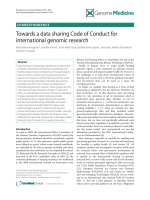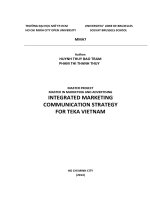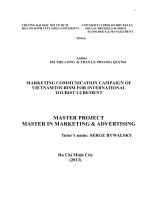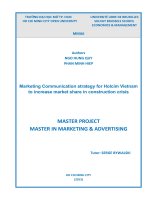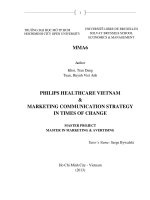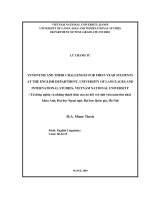Marketing communication campaign of Vietnamtourism for international tourist lurement
Bạn đang xem bản rút gọn của tài liệu. Xem và tải ngay bản đầy đủ của tài liệu tại đây (1.17 MB, 62 trang )
1
TRNG I HC M TP. HCM UNIVERSITY LIBRE DE BRUXELLS
HO CHI MINH CITY OPEN UNIVERSITY SOLVAY BRUSSELS SCHOOL
ECONOMICS & MANAGEMENT
MMA6
Author
DO THE LONG & TRAN LE PHUONG QUYNH
MARKETING COMMUNICATION CAMPAIGN OF
VIETNAMTOURISM FOR INTERNATIONAL
TOURIST LUREMENT
MASTER PROJECT
MASTER IN MARKETING & ADVERTISING
Tutor‟s name: SERGE BYWALSKY
Ho Chi Minh City
(2013)
2
PLEDGE
We commit that this thesis is our research which is accomplish under the instruction of
Professor Serge Bywalski.
Figures and researching results represented in this thesis are honest and have not been
proclaimed in any form.
We are hereby responsible for our research.
3
GRATITUDE
We are most grateful to Solvay-ULB for giving us the opportunity which made our project
possible.
We would like to thank Professor Serge Bywalski, Professor by Professors Philippe Biltiau
and Alain Van den Eynde for helping us in choosing the appropriate idea for our project.
Our utmost appreciation is forwarded to Mr. Kerry Kennedy – President of ITV Asia for his
supporting in presenting ideas of the work.
We appreciate Mr. Pham Quang Hung – Director of Vietravel Northern Brand for giving us
precious travelling documentation and comments on the project.
Last but not least, our warmest thank to our dear friend – Mr. Le Ha Tu – Assistant
Cummunications of Nielsen Vietnam in helping us to design the logo of the campaign stated
in this work.
4
TABLE OF CONTENTS
LIST OF FIGURES
LIST OF ABBREVIATIONS
INTRODUCTION
EXECUTIVE SUMMARY
Chapter 1: DESCRIPTION
I. Overview of Worldwide Tourism Since 2008
II. Vietnam National Administration of Tourism (VNAT)
1. VNAT Description
2. Achievements and Current Situation
3. Issues of Vietnam tourism
4. Case Description
Chapter 2: ASSESSMENT & CRITICAL REVIEW
I. TOURISM BRANDING
1. Positioning Vietnam tourism‟s image and core value
2. Visual design
II. TOURISM PRODUCTS
III. COMMUNICATIONS
1. Direct Marketing
1.1 Website
2. Sales Promotion
2.1 Travel fairs
2.2 Contest
3. Advertising
3.1 The TVC of “Impressive Vietnam”
3.2 Message Design
3.3 Message Performance
5
3.4 Media Selection
3.5 Print Advertising
3.6 Out door Advertising
IV. MACRO-ENVIRONMENT ANALYSIS
1. Socio-Culture
2. Legal
3. Economic
4. Political
5. Technological
6. Ecological
V. SWOT ANALYSIS
Chapter 3: RECOMMENDATIONS
I. TOURISM BRANDING
II. TOURISM PRODUCTS
III. PRICE STRATEGY
IV. BUDGET
V. DIRECT MARKETING
VI. SALES PROMOTION
VII. ADVERTISING
1. TVC
2. Display and Banner ads
3. Brochure
4. Outdoor
Chapter 4: MARKETING COMMUNICATION CAMPAIGN 2013-2015
I. CAMPAIGN SUMMARY
II. BRAND POSITIONING
III. BRAND
1. Reason for choosing Vietnamese cuisine as Vietnamtourism brand and image
2. Reason for choosing target markets.
IV. COMMUNICATION PLATFORM
V. COMMUNICATION OBJECTIVES
VI. COMMUNICAION IDEAS
VII. INTERGRATED COMMUNICATION EXECUTION
1. Advertising
1.1 TVC
1.2 Banner and Motion pictures
1.3 Print
1.4 Brochure
6
2. DIRECT MARKETING
2.1 Website
2.2 Social Networks
2.3 Google
3. Sales Promotion
3.1 Travel fairs
3.2 Contest
4. EVENT
4.1 Festival
4.2 Entertainment
5. PR
6. COMMUNICATION TIME FRAME
VIII. BUDGET ALLOCATION
IX. COMMUNICATION EVALUATION & MEASUMENT
CONCLUSION
APPENDIX
REFERENCE LIST
7
LIST OF FIGURES
Figure 1: International tourist arrivals in 2012
Figure 2: International Market Share in 2012
Figure 3: The development of international arrivals to Vietnam from 2001 to 2012
Figure 4: The number of Tourist by Nationality in 2012
Figure 5: The number of Tourist defines by Purpose of visit in 2012
Figure 6: The Distribution of transportation modes in 2012
Figure 7: Total number of international visitors by countries in 2012
Figure 8: Logo, slogan and image of Vietnamtourism from 2000-2013.
8
LIST OF ABBREVIATIONS
ASEAN Association of Southeast Asian Nations
APEC Asia Pacific Economic Cooporation
ASEM The Asia – Europe Meeting
FDI Foreign Direct Investment
GDP Gross Domestic Product
GSO General Statistics Office of Vietnam
MoCST Ministry of Culture Sport and Tourism
MICE Meeting, Incentives, Conference, Exhibition
PATA Pacific Asia Travel Association
UNESCO United Nations Educational, Scinetific & Cultural Organization
UNWTO World Tourism Organization
USTOA U.S Travel Association
VNAT Vietnam National Administration of Tourism
VAT Value Added Tax
WTTC World Travel & Tourism Council
9
INTRODUCTION
Vietnam has many beautiful dreaming scenes, various cultures, unique cuisine, stable politics,
friendly residents and many other potentialities for tourism development. With these
advantages, the country is supposed to get a larger number of international arrivals annually.
However, due to the lack of good marketing efforts, the country is still lagging behind many
other neighboring destinations.
This project will present the analysis of Vietnam tourism‟s campaign in 2009, and the
recommendations on its branding, products and communication campaign,etc. From threre,
bring out a new and efficient tourism campaign to promote Vietnam tourism with the hope to
introduce the country to global arrivals as a must-coming travelling destination.
Last but not least, to ensure the effectiveness of the campaign, a measurement part is
conducted at the end of the project.
10
EXECUTIVE SUMMARY
This communication campaign concentrates on attracting more international visitors to
Vietnam by using Vietnam cuisine as the country‟s tourism image and core value.
Although Vietnam tourism has had an impressive increase in arrival number during these
recent years, Vietnam still lags behind many other Asian countries and the nation‟s tourism
potentiality has not been matched due to a lack of overall strategies and an effective
marketing communication campaign. To make a successful campaign, many issues such as
the following need to be solved:
- Monotonous, low quality and less competitive services and tour packages
- Separate performance in strategic development and lack of co-operation amongst
regions, areas, Ministry of Culture, Tourism, VNAT, and other tourism related
businesses.
- Tourist length of stay too short time.
- Tourist spending still low.
- Tourist repeated rate are quite low.
To solve these above problems, solutions such as focusing on building tourism products on
variety and having more leisure forms and discovery should be brought out. Also, it is
important to focus on Culinary tourism, MICE tourism, Eco-tourism, Beach tourism, etc.
Having promoting regulations and policies to develop tourism and create close relationships
among tourism related industries from Ministry of Culture, Sport and Tourism (MoCST) to
locality for visitor comprehensive development. MoCST need to propose the Government for
larger budget to promote tourism. Focusing on advertising and choosing suitable media,
especially social means and developing official websites. The following steps are taken into
considerations: TVC (building four different video clips and one general clip), banner and
motion pictures, print, trade fairs, contest, festivals, entertainment and PR.
Through these steps, this project hopes to booster Vietnam tourism and bring more customers
and financial benefits to the country.
11
CHAPTER 1: DESCRIPTION
I. OVERVIEW OF WORLDWIDE TOURISM SINCE 2008
In 2009, total World's international tourist arrivals were 880 million with USD $852 billion in
revenue. Year 2009's profit was 0.7% less than 2008's. In which, Europe lead in both arrival
number and turnover (460 million international arrivals), which held more than half of total
market share. The 2
nd
winners were Asia and the Pacific region with 21% of the World's
international arrivals and occupied nearly a quarter of total tourism income.; however, since
late 2008, the number went down by 4.2% due to global economic crisis, affecting tourism
receipts to drop by 5.7%
. Among the World's regions, Asian tourism seemed less being
affected than of other nations. It reduced by only 2% of international arrivals while other
regions suffered loss around from 5% to 6% (Source: World Tourism Organization- UNWTO)
In 2010, the improvement of global economy brought out an increase in the World's tourism
situations. Whole World international arrivals climbed up by 6.7% and increased by US $58
million revenue
compared to 2009, reached 935 million arrivals and US $22 million revenue
more than the pre-crisis peak level in 2008, which was 913 million arrivals (Source:
UNWTO).
In 2011, despite an increase in uncertain global economy, political changes in Middle East &
North America and natural disasters around the World. International arrivals reached a record
of 982 million, an increase by 4.6% on 2010, while receipt grew by 3.8% to US $1.030
billion (Source: UNWTO).
In 2012, international tourism has continued to grow, despite global economic uncertainty
remain, making a new record to reach over one billion international tourist arrivals on early
December 2012. The figure cements tourism's position as one of the World's largest economic
sectors, accounting for 9% of global GDP (direct, indirect and induced impact), one in every
12 jobs and up to 8% of the total exports of the World‟s Least Developed Countries (Source:
UNWTO).
12
Figure 1: International tourist arrivals in 2012
Source: UNWTO
As shown in Figure 1, international tourist arrivals surpassed 1 billion for the first time in
history in 2012. By regions, Asia and the pacific increased by 7% was the best performer,
while the sub-region South-East Asia and North Africa increased by 9%, and Central and
Eastern Europe increased by 8% topped the ranking.
II.
Figure 2: International Market Share in 2012
13
II. VIETNAM NATIONAL ADMINISTRATION OF TOURISM (VNAT)
- Maintain average annual
number of visitor growth rate at
20% year on year
-Revenue increasing over 13%
year on year
- Everage GDP contribution at
12% year on year .
By 2015, Vietnam will have a
strong identity and worlwide
awareness as one of leading
country in culinary tourism.
Bring Vietnamese cuisine to the world
To be the leading country in
culinary tourism in the world
vVision
Mission
Objectives
1. Description
VNAT is a Governmental agency, it was officially established in 1978, forerunner of VNAT
was known as the Vietnam tourism company (established in 1960), which exercises the state
management function over tourist operations and activities throughout the country, under the
Ministry of Culture Sports and Tourism (MoCST).
It has full control in terms of business development, planning, public relations, personnel
training, conducting research, instructing and inspecting the implementation of policies and
other regulations in the tourism sector.
VNAT has quickly grown up, it has build a stable organizational structure and overcome
many difficulties from the early established day. Along with the innovation of the country, the
VNAT has prospered, rose to new management and development, achieved significant initial
results, increasing both the size and quality, gradually confirmed the role and position of
tourism management agency.
14
2. Achievements And Current Situation
Over 50 years since the establishment in early 1960s, Vietnam tourism has being
continuously developed step by step to participate in tourist activities of regional countries
and on the World.
Tourism business contributes a lot in the development of Vietnam economy. Tourism
activities create more than 1.4 million jobs in related business, helping to equalize economic
opportunities throughout the country. Tourism also help to improve the living conditions
through the new infrastructure investment include airports, roads, sewage system, historical
and cultural preservation, and environment conservation as well.
Vietnam's tourist segments are expanded from East & South Asia, North America and Europe
to other continents. To catch up a significantly increase in tourism demands, Vietnam has
focused on developing hospitality and infrastructure. In 2008, the country had 8,556
accommodations with total 170,551 guest rooms. It also had more than 600 international tour
operators. By the end of 2012, Vietnam had total number of accommodations estimated at
13,500 accommodations with 285,000 guest rooms, including: 57 hotels 5 stars; 147 hotels 4
stars and 335 3-stars hotel. The total of international tour operators are 1,120 companies.
Vietnam actively joined in cooperation of organizations; international and regional co-
operation mechanism about tourism such as ASEAN, APEC, ASEM, UNWTO, PATA.
As a result, tourism relationships with other countries have been improved and intensified e.g.
“Passion Indochine” with Laos and Cambodia, collaboration commitments with Sichuan,
Thailand, Egypt and Myanmar. Additional, the country participates many tourism fairs and
exhibitions while implements promotion activities.
International visitors come to Vietnam was only as half as those to Philippines and one
fortieth of Malaysia, Singapore and Thailand ten years ago. Year by year, the distance has
been shortened surpassed over Philippines. The recent tourism's annual growth rate is about
20%. To be detailed, there were only 2,3 million international arrivals to Vietnam in 2001. In
2006, it was up to approximately 3.6 million, then to more than 5 million in 2010. As
illustrated in Figure 3, the number of international arrivals to Vietnam had been upward fast
from 2001 to 2010, except a drop in 2009 due to the global economic recession.
Tourism has played an important role in Vietnam's economy, in 2011; Vietnam generated
VND 110,000 billion (USD 5.24 billion) in total tourism receipt and contributed to total GDP
5.8 % in 2012 (Source: Tourism Statistic, 2011).
In 2012, Viet Nam has welcomed and served 6.847 million international arrivals and 32.5
million domestic tourist trippers, gained revenue of 160,000 billion VND (USD 7.69 billion)
(Source: Vietnamtourism.gov.vn). This is a great encouragement for the efforts and
achievements of the tourism sector, confirming the role and position of the sector in the socio-
economic development of the country.
15
2.33
2.63
2.43
2.93
3.47
3.58
4.17
4.53
3.78
5.05
6.01
6.84
0
0.2
0.4
0.6
0.8
1
1.2
0
1
2
3
4
5
6
7
8
2001
2002
2003
2004
2005
2006
2007
2008
2009
2010
2011
2012
Figure 3: The international arrivals to Vietnam from 2001 to 2012 (million)
Source: Vietnamtourism.gov.vn
China, 1428.693, 21%
Korea, 700.917, 10%
Japan, 576.386, 8%
USA,
443.826, 7%
Taiwan,
409.385, 6%
Cambodia,
331.939, 5%
Malaysia, 299.041,
4%
Australia, 289.844,
4%
Thailand,
225.866, 3%
France, 219.721, 3%
Singapore,
196.225, 3%
Rusia, 174.287, 3%
England,
170.346, 3%
Others, 1381.204,
20%
Figure 4: The number of Tourist by Nationality in 2012
Source:
16
According to the statistic, Chinese tourist is in the 1
st
ranking of foreign arrivals to Vietnam in
2012 (21%), followed by visitors from South Korea (10%), Japan (8%), USA (7%) and
Taiwan (6%).
Figure 5: The number of Tourist defines by Purpose of visit in 2011 and 2012
Soure:
By Air
5575.904
82%
By Sea
285.546
4%
By Road
986.228
14%
Figure 6: The Distribution of transportation modes in 2012
Source:
The report of World Travel and Tourism Council (WTTC) in April 2011 claimed that Vietnam
ranked
47th, 54th and 12th respectively in terms of the overall tourism development, the
sector's contribution to the national economy, and the long-term (10-years) tourist growth.
17
With temperate climate, stable politics, natural richness, antique architecture and amazing
beauty of beach cities, the nation was honored to be chosen as many large and prevalent event
destinations such as APEC Summit 2006, Miss Earth 2007, Miss Universe 2008 and Miss
Earth 2010 and the forth International Fireworks Competition 2011, 2012.
In mid-November 2010, PATA and Visa International Company surveyed on 7000 people at
more than 10 countries and territories to bring out the announcement that the country is the
destination favored by many international tourists, especially tourists from America, China,
Australia, Russia, Singapore, Japan and Thailand. In May 2011, TripAdvisor© - World's
listed Ha Long Bay and Hoi An Antique Town in the "Top 25 Destinations in Asia". The
nation was also introduced in 50 Tours of a Lifetime (the sixth publication released by
National Geographic) which recommended "a 14-day-excursion" with "action-packed with
quintessential Vietnamese experiences". Furthermore, Lonely Planet recently added Sapa in
Top 10 places to walk to be in amongst the World's best tourist attractions like the Mount
Cook in New Zealand, Grand Canyon in the U.S., Torres de Paine in Chile or Lake District in
England (Source: Lookatvietnam.com, May 2011).
In addition, according to tourism competitiveness index, Vietnam ranked 14 in the list of the
most attractive destinations for developing the travel and tourism industry in the Asia-Pacific
region in 2011. According to the results of the survey Global Travel Trends 2011, "The
natural landscape, the promotional package tourist attractions as well as the political stability
is considered to be the main advantages to travelers are choosing to Vietnam in the future.".
Another survey of North American's largest travel firm Travel Leaders Group, the items voted
for "The location is becoming" hot "in Asia, Vietnam received 48.3% votes of the forecast for
this location. Furthermore, in late 2012, Members of U.S Travel Association (USTOA) had
predicted that Vietnam will become a second most favorable country in the world in "non-
traditional" destination, after Myanmar, in 2013.
18
3. Issues of Vietnam Tourism
Although Vietnam tourism grows with optimistic results and currently has the number of
international higher some countries, it still lag behind many other Asian tourisms such as
Indonesia, Singapore, Thailand and Malaysia. There are some issues for Vietnam tourism as
following:
- Monotonous, low quality and less competitive services and tour packages
- Separate performance in strategic development and lack of co-operation amongst
regions, areas, Ministry of Culture and Tourism, VNAT, and other tourism related
businesses.
- Tourist length of stay too short time.
- Tourist spending still quite low.
- Tourist repeated rate are low percentage
Figure 7: Total number of international visitors by countries in 2012
Source: Data collected from PATA
19
4. Case Description
From the Q4/2008, the number of international visitors to Vietnam strongly decreased down
compared with the same period of 2007. And the total number of international visitors to
Vietnam in 2008 only increased by 0.6% while Singapore increased by 4.8% , Indonesia &
Malaysia increased by 13.3%. These figures show the passive reaction of Vietnam tourism in
decreasing rank compared with the nearby countries.
In 2009, the Vietnam National Administration of Tourism (VNAT) decided to launch the
largest-ever promotion campaign with the hope to lure more foreign visitor to come to
Vietnam with targeted amount: 4.5 million foreign visitors and VND 78,000 billion
(US$4.2billion) in revenue, named "Impressive Vietnam" in slogan " Charming Vietnam"
and "Vietnam - the hidden charm" had been used since 2005.
During this campaign, more than 300 discounted tours were released, including many tours
for both foreign and domestic tourists with set price lists. The tour programs are beach and
island holidays, heritages sightseeing, visitting cultural and historical sites, biodiversity
tourism (trekking, cycling tour, adventurous; sport tours (motorbike tours, diving) and luxury
tour (resort relax, golf tour, cruising tour).
Nearly 100% hospitality facilities such as national flag carrier Vietnamairlines, hotels, resort,
tour operators, travel agents, tourist transporting services, and souvenir shops joined in this
special offer campaign with discounted prices from 30 -50% for visitors coming to Vietnam
from January to September 2009. To support to this campaign, Prime Minister Nguyen Tan
Dung decided to cut 50 percent of VAT (Value added tax) for businesses, and travel agents
which serve all-in tours, and tourist transport service.
Furthermore, in May, VNAT announced that during the period of Impressive Vietnam,
foreigner visitors who entered Vietnam on the campaign's package tours would be exempted
from visa fees, it was effective from 15
th
May to the end of September. They could visit
www.vietnamtourism.gov.vn/impressivevietnam to update promotional packaging information
and book the services.
The budget for the campaign was about VND 25 billion (USD $1.47 million). This time,
they made contract with the global BBC television channel, and the payment was US$
204,000 for total 320 broadcasts, each was 30-second-spotfeaturing. It featured a panorama of
Vietnam and its people. That was the first time Vietnam has promoted its national image
globally through television. To produce the program, a production team from the BBC visited
the country to shoot scenes and select music. The 30-second clip highlighted Vietnamese
food, tricycles (Xich lo), water puppets, the traditional dress (Ao Dai), Hanoi architecture, Ha
Long Bay and the floating market on the Mekong River. Viewers have also been shown
beautiful beaches in the central region, the customs of ethnic people in the northern hills and
dynamic Ho Chi Minh City. The clip has been broadcasted on BBC World News channel
twice a day at 6.45 and 21.20. It was being shown 20 weeks from March 2009 to July 2009,
in which 6 weeks in Europe, 8 weeks in Asia and the Pacific, and 6 weeks in America. It
counted for total 200 countries throughout the World.
20
Apart from television advertisements, the VNAT advertised on taxies on London streets from
the 1st July 2009 (Source: VOVnews, 2009). Vietnam signed a USD $30,436 contract to order
the 27 London black cabs to put an image of Vietnamese schoolgirls in Ao Dai and conical
hats (Vietnamese people symbol) and the image of Ha Long Bay on their cars taxies with
slogan "Charming Vietnam" for six months.
In more detailed, The Ministry of Culture, Sport and Tourism, Vietnam Airlines and the JATA
(Japan Association of Travel Agents) had coordinated to attract more Japanese tourists to
Vietnam by carrying out "Impressive Vietnam" in Japan. Top Japanese travel agencies such as
APEX, JTB and HIS also joined this campaign. Many activities to promoting programs had
held throughout may countries:
Road show Melbourne, Australia as part of its global travel outreach series on 16
st
February 2009
Attend and performed at the Fair Tongtong - Holland (June 2009)
Vietnamese Culture Week at UAF and night Vietnam in Belarus (July 2009)
Road show in Beijing, China (August 2009)
Vietnam Week in South Africa (August 2009)
Vietnamese Culture Week in the United Kingdom (October 2009)
Vietnamese Culture days in Laos (September 2009)
Vietnam Week in South America (September 2009)
Tourism Festival - Vietnamese culture in the U.S. (December 2009)
A press trip with a group of 19 reporters, photographers of the leading travel magazines such
as National Geographic, Travel & Leisure, CNN Traveler, Voyage, Photographer, Lifestyle
Travel Asia, Business Traveler, The Improper had invited to Vietnam to promote the
campaign on April 2009.
Besides that, the image of Ha Long bay and the legacy of Vietnam had appeared on the
UNESCO World Heritage Magazine - one of the only magazine specializing in world heritage
and highly reputed international scholars in heritage tourism.
"Impressive Vietnam" campaign was also promoted by the presence of relay in Jetstar
Magazine (Jetstar Airways) with over 1 million readers on all domestic flights in Australia,
and international flights to New Zealand, Japan, Indonesia, Hawaii and Vietnam. Besides the
promotion page and an article about Vietnam's tourism magazine Jetstar ASIA of Jetstar Asia
Airlines was also introduced and disseminated information about "Impressive Vietnam" in
international flights of Jetstar Asia to Malaysia, Indonesia, Cambodia, China, Thailand,
Philippines, Taiwan and Vietnam.
21
As a result, in 2009, the campaign saw a strong growth in the domestic tourist market. This is
considered to be the most significant success. The number of domestic tourist increased by
19% compared to 2008, reaching 25 million. Total revenue was measured about VND
$70,000 billion (US$ 3.78 billion), 9% increased over 2008. However, Vietnam welcomed 3.8
million foreign arrivals only, 11% drop from the previous year.
22
CHAPTER 2: ASSESSMENT AND CRITICAL REVIEW
The "Impressive Vietnam" had launched from January to September 2009, and had extended
till December 2009. Through the campaign, many weaknesses, unprofessional and
disadvantages of Vietnam tourism compared with other competitors had revealed. As a result,
Vietnam tourism had not reached an expectation number of international visitor as planned.
I. TOURISM BRANDING:
A brand is "a name, term, design, symbol, or any other feature that identifies one seller's good
or service as distinct from those of other sellers", according to American Marketing
Association, it is any label that carries meaning and associations.
The reason that Vietnam has less foreign tourists than Thailand, Malaysia and Singapore is
that it has not yet built both a successful tourism brand and a distinctive country's image to
the world. Hence, to build brand image and awareness, united and clear message, core values
are essential parts in long term strategy for the tourism development.
1. Positioning Vietnam tourism's image and core value
The country has not been successful in introducing to the world its beautiful landscape,
friendly people with diversified and unique culture. Impressive Vietnam spent tourism
marketing budget into television advertisement on CNN, BBC, etc. which did not bring out
the best results due to lack of a unique image and a clear message. It brought to the world two
main memories which are Ao Dai and Ha Long bay. However, Ao Dai seems less impressive
to foreigners than Kimono (from Japanese), or Hanbok (from Korean). With Ha Long bay,
UNESCO heritage, and one of the New Seven Natural Wonders of the World, could not make
a strong memory because lack of country promotion.
Compared to Vietnam, other developed-tourism countries have a cleverly created and
communicated images and messages for branding tourism and the whole country. They have
their own "words" so that when people say about these words, they immediately think of the
nations. For instance, Thailand was successful in creating its brand image of "exotic, fun, and
friendly people". The first two words imply distinctive entertainment. Another success is
Singapore with “Shopping Paradise” image has embedded in many visitor‟s memory.
In other word, it is the core values the countries would like to offer to visitors. On the other
hand, potential visitors did not see the core values of Vietnam tourism campaigns. Even
though its cuisines are loved by many foreign visitors and proposed to be a competitive
advantage for Vietnam tourism by Kotler (The SaiGon Times 2011), and Ha Long Bay which
is supposed to be the must-visit destination, the nation still cannot strike potential visitors
with those.
23
2. Visual design
During the last ten years, Vietnam National Administration of Tourism has changed slogan
and logo four times. They are Welcome to Vietnam (since 200 to 2005), Vietnam -
Destination for The New Millennium, Vietnam - The Hidden Charm (since late 2005 to 2011)
and Vietnam- Timeless Charm (from 2012). These are general and unfocusedly used,
compared to other countries with Amazing Thailand, Uniquely Singapore, Your Singapore
(2011), Malaysia, Truly Asia, Incredible India, Visit Indonesia and Wonderful Indonesia
(2011).
Figure 8: Logo, slogan and image of Vietnamtourism from 2000-2013.
The incoherency in Vietnam tourism's slogan and logo affects negatively to tourism branding.
Malaysia used "Truly Asia" for a long period and only added subheading which followed the
main slogan, as in accordance to purpose and theme of each campaign, without completely
change into another one. Hence people memorize the brand much more than competitors.
Additionally, Vietnam tourism‟s logo- a lotus is considered to be not clear. It is hard for
foreigners to realize that it is a stylized lotus and its meaning as a result of lack of culture
promotion
Key finding:
Incoherency in Vietnam tourism's slogan and logo affects negatively tourism
branding.
Vietnam has lack of a unique image and a clear message. Building brand image
and awareness, and clear message, core values are important for tourism
development.
24
II. TOURISM PRODUCTS
Vietnam has only 15% of repeated visitors; it is too few compared to the giant competitor
Thailand. One of the reasons for this disappointed result is of the monotonous and low quality
tourism products (Ha Noi Moi, September 2011). Following tourism experts, Vietnam
tourism's products are like "stick shape" which means that when visitors come to Vietnam,
especially groups, they just to travel from North to South or South to North in 15 days then
finish, and they do not have a need to come back, because they can visit all famous tourism
spots at their first time visit.
Thailand is different, if visitor wish to visit North to South, it take one month to visit,
Thailand tourism devided into various routes to visit. Visitor visit Pattaya takes 6-7 days,
Phuket takes 4-5 days, Bangkok 3-4 days…Thailand's tourism products like "blooming
flower" and then "tie" visitor come to visit many times.
Generally, the tourism products in the "Impressive Vietnam" are quite monotonousness and
low quality. Many tour operators have the same products and concentrated on the most
popular destinations. The tour programs are mainly in beach and island holiday, heritages
sightseeing, visiting cultural and historical sites, biodiversity tourism (trekking, cycling tour,
adventurous; sport tours, and luxury tour. Vietnam tourism's advantage is the nature-based
beauties lying the country length and a long lasting cultural and historical background.
However, stunning natural beauty or common cultural sightseeing are not the only factors that
creates tourism success because it lack of fun and leisure activities. These fun and leisure
activities mainly push for 5-star hotels, resorts and golf courses which can attract a limited
number of high income people only, while Vietnam have entirely ignored a diversity of other
more affordable activities such as adventure sports, walking tours and theme parks.
Furthermore, In "Impressive Vietnam", the local culture had not been effectively exploited,
especially activities for foreign visitors. Many countries in the world have been successful
exploited their local culture, example: Bull-fighting in Spain, or Oktoberfest in German.
Through these activities, visitors can mix with local people to experience and enjoy their
feeling. Vietnam's nature landscape and cultures are not inferior than others competitors, but
how to promote them and how to "sell" this feeling to visitors are the most important things.
Key finding:
Tourism products are quite monotonous and low quality. Many tour operators have
the same products and concentrated on the most popular destinations.
Lacking of fun and leisure activities, especially affordable activities such as
adventure sports, walking tours and theme parks.
The local culture had not been effectively exploited, especially activities for
foreign visitors.
25
III. COMMUNICATIONS
1. Direct marketing
1.1 Website
Vietnam tourism official website www.vietnamtourism.gov.vn/Impressivevietnam was mainly
about tour programs, list of tour operators, destinations, travel guide and some upcoming
events and festivals, culture, weather, news, promotions, etc., they are complicated, confusing
and generally not user-friendly. It was old-fashioned, tedious and uninspiring due to lack of
interactive features, spectacular gallery and exciting content. In addition, "Impressive
Vietnam" was advertised in many country and regions, Vietnam also has become a global
tourist destination, but the website only had 5 languages: Vietnamese, English, Chinese,
Japanese and French.
Look at some other tourism sites of competitors such as Malaysia and Thailand, they have
more than 20 languages to attract their targeted markets.
Furthermore, there was no button linked to any social networking such as Facebook, Twitter,
Youtube and Myspace found on the official site. These will be the best channels to remind
people to launch new campaign and update upcoming events, festivals but they were not be
integrated into the website.
Key findings:
Vietnam tourism official website was not user-friendly. It was old-fashioned,
tedious and uninspiring. Moreover, the website had only 5 languages, not suitable
to a global promotion campaign.
There was no button linked to any social networking such as Facebook, Twitter,
Youtube, Myspace found on the official site to remind people to launch new
campaign.
2. Sales Promotion
2.1 Travel fairs:
The travel fairs are mainly activities for sales promotions in “Impressive Vietnam”. There
were many representatives of Airlines, hotels, tour operators participated in international
travel fair, but they rarely associated to establish an impressive "Zone of Vietnam" at the fairs.
They used to make a separate stall to advertise for their products and services. They put their
stall in a separate corner of the enterprise at a different angle with very little images, poor
information about Vietnam. Even some employees of these stall in the fair had sold souvenirs
to earn a little money to buy gifts instead of actively provided travel information about
Vietnam tourism, and their business.
Meanwhile, Most countries participated in the international tourism fairs usually rent a
private area with special design, their overall picture presented a professional manner of their
culture. There were exhibition area, related tourism business companies, and general area
introduce their culture, cuisine, art shows, fashion, etc.


